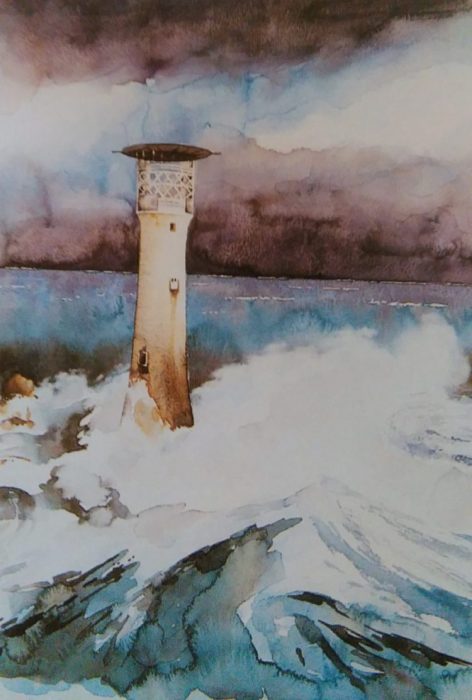Painting stormy weather has always been a real challenge for the artists. Even tho it is possible to reconstruct the sight using photographs nothing can compare with trying to capture the grandeur of the storm on sight. Painting is a creative process so apart from sight all the other sense are involved.
All the sensations that you get while watching the storm will reflect on your painting. The storms come and go very quickly so you have to learn how to paint storm clouds swiftly on sight and then finish your painting in the commodity of your studio.
Sky And The Sea
For this painting you will need the following:
- One sheet of cold pressed watercolor paper
- Big decorators brush
- Flast 13mm brush
- Round sable brush number 2
- Round sable brush number 0
- Small old brush for application of gouache
- HB pencil
- Soft Tissues
- Bowls for mixing the paint
You will also need the following colors:
- Cyanine Blue
- Cadmium Red
- French Ultramarine
- Burnt Sienna
Use the HB pencil to sketch the line of the horizon, the lighthouse and the contour of the rocks in the front plane. Use gouache and with the small round brush go over the lighthouse and the white areas of the waves that are hitting the cliffs in the distance.

Using the gouache will allow you to paint the sea and the sky with bold relaxed moves not having to worry about smearing the other elements of your painting. Mix Cyanine Blue with a bit of Ultramarine and dilute it with water well. Tilt the drawing board and paint the upper part of the sky using the big decorators’ brush. If the paint starts to pile up at the end of the spread simply dry the brush and remove it.
With blue spread paint the bottom part of the sky and then go to painting some parts of the water. Leave the big wave that hitting the cliffs white for now.
Mix a very wet but still strong mixture of French Ultramarine and Cadmium red and paint the heavy purple storm clouds spreading the paint on the paper with wide brush strokes.
Wash the paintbrush and than use it to smudge the edges of the clouds in order to create a mild gradation of the paint that depicts fog and rain.

Adding The Details
While the purple spreads are still wet add here and there new spreads to darken the paint. Don’t get tempted to make a smooth brush stroke but let the paint to spread creating the impression of storm clouds that are piling up.
Mix wet but still strong solution of Cyanine Blue, French Ultramarine and a little bit of Cadmium red and ad the spreads of different tones across the distant areas of the sea using the 13mm flat brush.
Start painting the area inside the waves that are crashing the cliffs in the front plane of your painting. Add the paint from top to bottom with rhythmical moves to depict the force of the water.
Same as you did with the sky allow the paint to form small puddles and curvy patterns, that will add to the dynamic and the strength of the waves.
Add more pigment to your color mixture to strengthen and develop dark shades within the wave that is smashing on the rocks.
In order to depict the sea water that is changing into foam ad some water on the edges of the brush strokes to weaken the color.
The foam on the top of the wave that is crashing against the rocks is painted with smudgy moves done with the small amount of paint on a dry brush which was gently dragged across the paper with the moves directed upwards.
In order to depict the water splatter when the waves hit the rocks soften the edge of the blue spread with a wet brush and then gently smear it using a piece of tissue.

Finishing Touches
With the edge of eraser remove the gouache from the lighthouse and the waves in the distance. Swiftly go over the contours with round sable brush number 2 to soften the firm edges created by the gouache.
Mix diluted spread of Burnt Sienna and French Ultramarine and paint the lighthouse walls starting with a very pale spread at the top that gets darker as you approach the bottom of it.
Use round sable brush number 0 and paint the details on the top of the lighthouse with different shades of grey. Paint the dark windows with a dark mixture of Burnt Sienna and French Ultramarine.
Step away from your painting to asses what you have achieved so far. Add some details if you think they are needed.
In the end, paint the rocks on the left side of the lighthouse using the dark mixture of Burnt Sienna and
French Ultramarine. On the completed painting you will notice that the wave that is crushing against the rocks in the font plane mostly consists of the whiteness of the paper whose brightness is made stronger with the dark shades of the surrounding sea and sky.
If you have any questions regarding this subject feel free to leave them in the comment section and I will be more than happy to help.





0 Comments